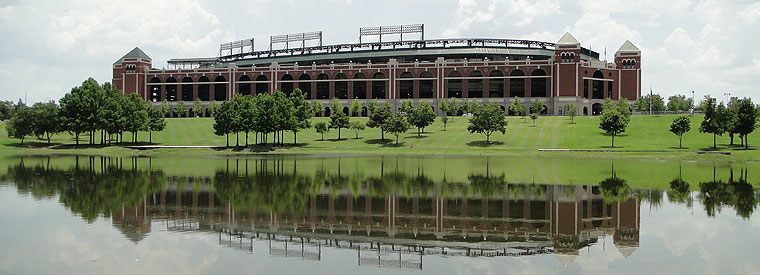
|
Call it what you will, but the Rangers' ballpark in Arlington is about as pretty a place as you'll ever see upon approach. Built alongside a 12-acre lake, arches are cut into the picturesque brick facade of the ballpark, which is the only fully enclosed one to open in the ballpark renaissance era that began in 1992.
The Rangers' stadium is enclosed thanks to one of its more distinctive features: a four-story office building that's in center field. The top three stories of the office complex are leased by regular (non-baseball) businesses and the field-facing balconies they enjoy are quite a perk for each of the lessees. Appropriate for Texas, the ballpark is a big one as it contains 48,114 seats. Except for in the Big Apple, no American League ballpark in America has a larger capacity (Toronto's Rogers Centre is north of 50K) and the large upper deck that holds many of those fans is topped with a white frieze, a la Yankee Stadium, but less gaudy than New York's example. The double-deck covered "home run porch" in right field in Arlington is a nod to another classic ballpark, Detroit's Tiger Stadium, and atop its roof is a 42' by 120' high-definition scoreboard. Something original to Arlington's yard is the grass berm batter's backdrop in center field, upon which fans can scamper when a home run is hit there. It's the majors' only fan accessible outfield grass embankment. Heat and humidity go hand-in-hand during most of the baseball season in Texas and there is no reprieve from it in the venue often affectionately referred to by locals as simply "The Ballpark," which was the first of four names to primarily grace the place. An insurance company based in Oklahoma bought the name to Texas' ballpark in 2014, so it's now called Globe Life Park (in Arlington, which has always been a part of the name). Since the stadiums in other notoriously hot major league host cities (Houston, Miami, Phoenix, St. Petersburg) all have roofs, whether fixed or retractable, Globe Life Park in Arlington is the most likely place in which you can watch big league baseball in 100-degree heat. It was the first MLB park in which I did -- in July of 2011 -- and I'm sure plenty of other people can say the same thing. And many, if not most, people will also say this is what a ballpark should look like, especially on the exterior. That much can be controlled. The weather cannot, and if that's the biggest strike against a place, then just about everything that could be done right was.

Globe Life Park Facts & Figures
| |||||||||||||||||||||||||||||||||||||||

